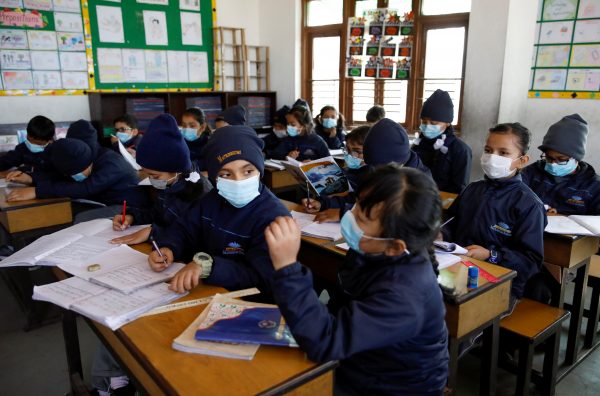Over half of total education spending funds basic education — from pre-primary to eighth-grade — and about a quarter is spent on secondary education — ninth-grade to 12th-grade. Around 8 per cent supports tertiary education and the lowest share of the education budget — 3.0 to 3.5 per cent — is spent on technical and vocational education and training (TVET).
Achieving universal basic education is the main priority of the Nepalese government, with its key focus on enhancing access, equity and quality. Increasing emphasis on education and investment is contributing to improving educational access for Nepal’s youth. Notably, progress in school enrolments is observable at the primary level where the net enrolment ratio crossed 97 per cent. All school levels have also achieved gender parity with equal representation of male and female students.
But despite the progress, student retention is a persistent challenge. Dropouts are a major problem and are associated with reduced enrolment rates in each subsequent higher level of education. Almost 80 per cent of students leave the education system before completing schooling at the secondary level. It is estimated that around two million school-age children are not in school across Nepal.
Still, how does the government’s rhetoric on education stack up against the reality? The main goal of education in Nepal is to contribute to workforce development and poverty reduction. Indeed, the public expect an education to provide better life outcomes for themselves and their children. They want decent employment and a higher standard of living. Employers searching the labour market also want education to provide a more skilled, work-ready population. Improving the quality of education and strengthening the ease of transition from school to work are major issues facing Nepal’s youth, their families and policymakers.
But the government’s focus on achieving basic education in its present state of delivery does not always provide the knowledge and skills to secure a job, income source and a pathway out of poverty. Given the prioritisation of resources to basic and secondary education, the youth that are no longer in school are left largely unsupported through their transition to work.
Students reaching higher levels of education in Nepal also develop skills that are not relevant to the labour market. There is too great of a focus on academic skills — the labour market does not have the capacity to absorb all graduates who aspire to high-level managerial and professional jobs. In reality, the education system produces a mass of unemployed educated youth that possess skills without a clear connection to labour market needs. This raises questions on the quality and practical relevance of education in Nepal.
Education policy focusses on providing quality education for all, but the existence of two types of schools — public and private —impedes this. Parents generally prefer to send their children to private schools. They believe a private school education will provide high-quality education with a better return on investment and improved life outcomes. Employers also see privately schooled students as more competent and qualified. But only the children from wealthier families can access these private schools.
Education is normally a key tool to address inequality, but the private education system in Nepal instead perpetuates inequality. It furthers social division among different class, caste, gender and ethnic groups, increasing the divide between rich and poor. The privatisation of education also instils a sense of class consciousness at the early stages of childhood. When children start school, they immediately face social stratification.
Nepal needs to improve its education system so that education not only gives hopes and dreams to its youth, but also helps them fulfil those dreams. The government must improve the quality of the public education system, and urgently establish a clear link between education and the labour market to produce more work-ready graduates. Education must also be demand-driven. School and university curriculums need to be reviewed with meaningful engagement from employers. Emphasis and investment in TVET — especially targeting those who do not pursue higher education — would also be helpful.
By ensuring these priorities are met, education can work as a tool to reduce inequality in Nepal rather than further it. The Nepalese education system and the country’s policymakers must refocus their efforts on achieving a fairer, more equitable education system.
Anil Paudel is CEO at Right4Children, Pokhara.

